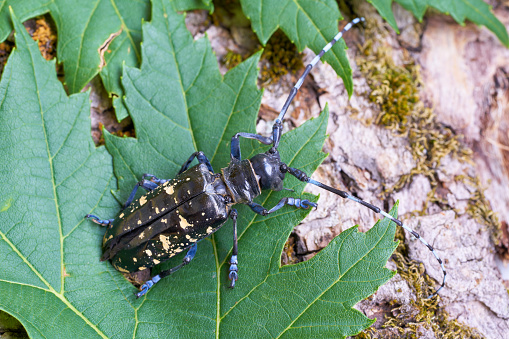
Watch Out For These Bugs That Kill Trees In Michigan
There is no shortage of bugs that kill trees in Michigan. Wood-boring insects are abundant. And it takes a proper pest control plan to keep them at bay.
Invasive insects are one of the biggest threats to your trees. Fungal infections also cause problems, and oftentimes it’s a bug that causes a disease to develop in a tree or shrub. That’s why it’s important to learn to recognize invading insects, as well as signs of insect or fungal infestation such as holes in trees, sawdust or leaves turning brown at the wrong time of year.
So, let’s find out which bugs are most troublesome.
Bugs That Kill Trees In Michigan
Asian Longhorned Beetle
The Asian longhorned beetle can attack and kill many tree species including poplar, willow, sycamore, and horse chestnut, but its favorite host is maple trees.

Adult female beetles chew depressions in trunks and branches where they lay their eggs. When the larvae hatch, they burrow into the tree’s heartwood, creating large chambers. The larvae feed in tunnels in the wood of the tree branches and trunks, eventually killing the tree.
The new adults emerge in the summer by boring round exit holes about three-eighths of an inch in diameter.
Brown Marmorated Stink Bug
The most common stink bug in Michigan is called the brown marmorated stink bug (Halyomorpha halys). Brown marmorated stink bugs are an invasive species originally native to Southeast Asia. In Michigan, they live around the tree fruits, vegetables, ornamental plants, and legumes they feed on.

The brown marmorated stink bug not only can affect yields in fruit, nut, legume, and vegetable crops, but it can also become a nuisance in indoor environments where they overwinter — like in your house.
Gypsy Moth
Gypsy moths are an invasive species. They feed on the leaves of more than 300 species of trees in Michigan and across much of the northeastern United States. They especially like oaks but many other trees are also good hosts.
The leaf-eating caterpillars are hairy, up to 2 inches long, and have a pattern of blue and dark-red spots. Male moths are dark buff in color and fly; females are white with black, wavy markings and do not fly. These insects are ravenous feeders. A single caterpillar can eat its way through 10 square feet of foliage as it grows. Trees that are infested with these caterpillars can be completely defoliated, and become weak and more susceptible to other problems, potentially killing the tree.
Japanese Beetle
Adult Japanese beetles are easy to identify. They’re about 3/8 inch long, metallic green in color, and emerge from the ground in late June.

They feed in groups, starting at the tops of plants, then work their way downward. Individually, Japanese beetles don’t consume much. But collectively, their damage can be devastating.
The types of trees they often target include:
- Linden
- Crape myrtle
- Flowering crabapple
- Norway maple
- Japanese maple
- Flowering cherry
- Elm
- Sycamore
- Black walnut
- Horse chestnut
- Plums
- Roses
There are a lot of products on the market to get rid of them, but you need to be cautious — especially if you use traps. The traps are designed to lure the beetles in, so you may attract more beetles than you already have.
Emerald Ash Borer
If you have an ash tree, you may have noticed small green flying insects attacking your tree. This insect is called the emerald ash borer and has been labeled the most destructive pest in America.
They lay their eggs on the ash trees. After about two weeks, the eggs will hatch and the larva will bore their way through the bark.
Outbreaks and infestations of emerald ash borer are announced very frequently. To find the most current information on the locations and status of each state, province, and county, it is best to go to Emeraldashborer.info or access their current map, typically updated once a month.
Controlling Bugs That Kill Trees
The Safari Tree pest control package combines killing insects and their larvae by strengthening your tree so it can survive the pests that do manage to attack. It starts in the spring when we’ll spread dormant oil on your trees. This will immediately begin to cut down on early insect infestations. We then fertilize your tree’s deep roots later on in the season, allowing it to get off to strong growth.
Find the treatment that will protect you, your family, your trees, and your entire yard. Contact us today.





